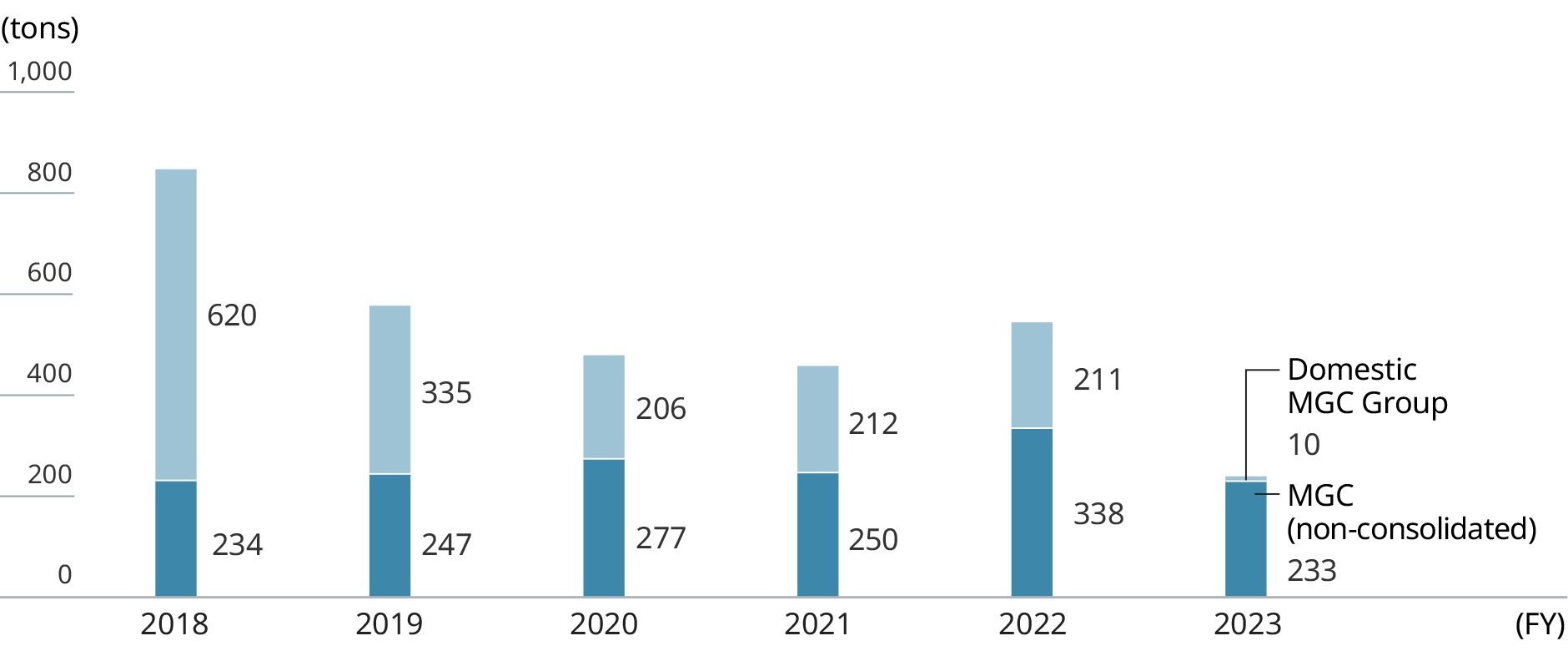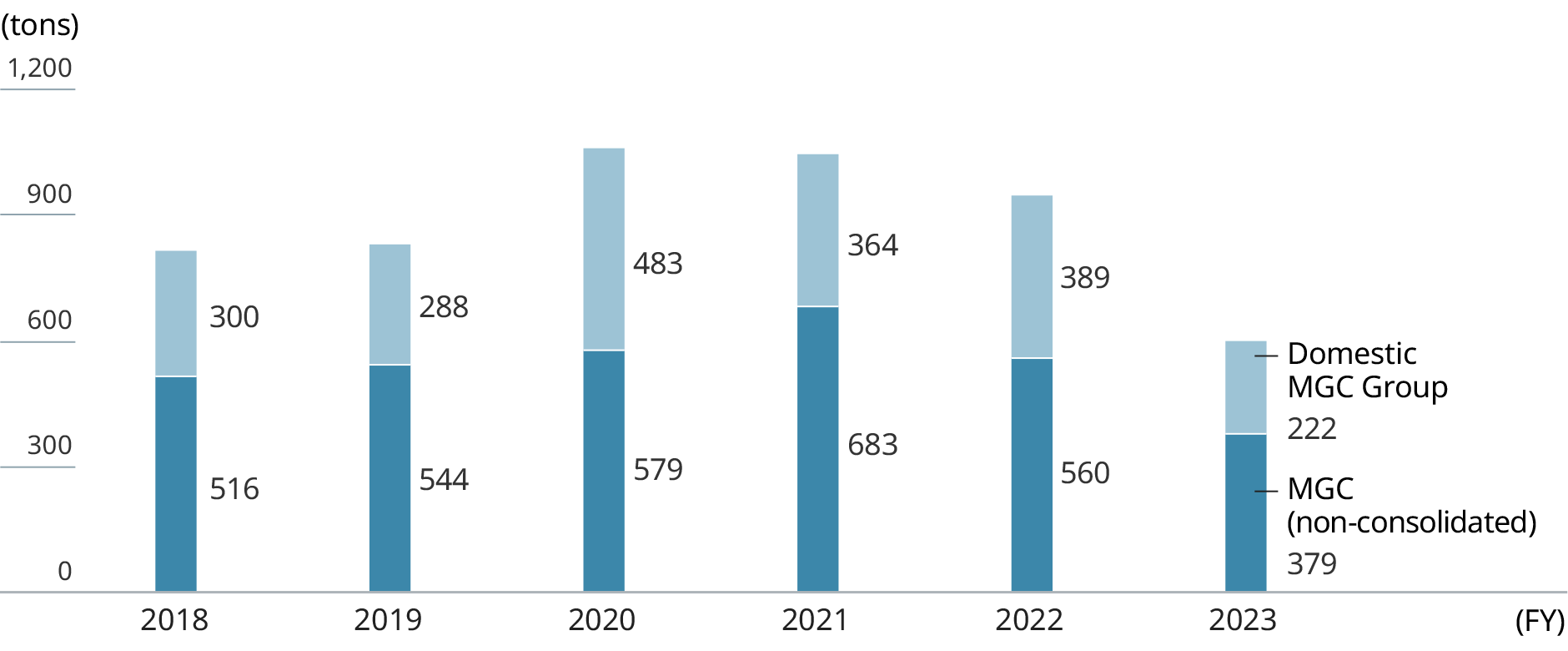Chemical Emission Reduction
PRTR-Related Matters
MGC non-consolidated and domestic MGC Group companies assess and submit notifications on released and transferred substances subject to the PRTR scheme under the Act on the Assessment of Releases of Specified Chemical Substances in the Environment and the Promotion of Management Improvement (PRTR Act) while working to reduce the amounts released and transferred.
Substances Subject to Notification under the PRTR Scheme (MGC non-consolidated and domestic MGC Group companies)
Quantities of released and transferred substances for which notice was submitted under the PRTR scheme by MGC non-consolidated and domestic MGC Group companies were aggregated.


* Past data has been reviewed and numerical values have been corrected.
High-emission Substances for Which Notice Was Submitted under the PRTR Scheme (MGC non-consolidated and domestic MGC Group companies*1)
Among the substances for which notice was submitted under the PRTR scheme, those listed below were emitted by MGC non-consolidated and domestic MGC Group companies in total in amounts of 10 tons or more.
| Government-designated number | Substance | Emissions (tons) | |||||
|---|---|---|---|---|---|---|---|
| FY2019 | FY2020 | FY2021 | FY2022 | FY2023 | FY2024 | ||
| 691 | Trimethylbenzene*2 | 162 | 162 | 121 | 216 | 97 | 97 |
| 186 | Dichloromethane | 74 | 78 | 69 | 56 | 40 | 36 |
| 731 | Heptane | - | - | - | - | 9 | 19 |
| 300 | Toluene | 14 | 14 | 15 | 13 | 13 | 17 |
| 80 | Xylene | 20 | 11 | 29 | 32 | 13 | 13 |
| 65 | Epichlorohydrin | - | - | - | - | 15 | 12 |
| 213 | N,N-Dimethylacetamide | - | - | - | - | 27 | 0 |
*1: Until FY2022, the emissions represent the data of MGC Group Environment and Safety Council. (Including Equity method affiliate)
*2: Until FY2022, the substance was 1,2,4-Trimethylbenzene (Former government-designated number:296)
No.213 N,N-Dimethylacetamide:Temporary increase in emissions due to leakage
No.65 Epichlorohydrin : Increase due to a revision of the calculation methodology
VOC Emissions (Non-consolidated)
Below are the emissions of the Japan Chemical Industry Association (JCIA) and PRTR-targeted substances at MGC (non-consolidated). These are the atmospheric emissions of substances that are considered volatile organic compounds (VOCs) under the PRTR system plus the atmospheric emissions of the 25 substance groups independently designated by the JCIA as JCIA PRTR-targeted substances.
| FY2019 | FY2020 | FY2021 | FY2022 | FY2023 | FY2024 | |
|---|---|---|---|---|---|---|
| PRTR-targeted(tons) | 269 | 266 | 237 | 327 | 196 | 152 |
| JCIA-targeted(tons) | 376 | 339 | 298 | 379 | 247 | 205 |
MGC will continue its efforts to reduce emissions of chemical substances occurring in conjunction with the unplanned shutdown and startup of equipment and similar factors, by implementing measures to reduce problems at manufacturing plants and through preventive measures.
Act on Rational Use and Appropriate Management of Fluorocarbons
MGC is conducted and records are retained, the amounts of leaks are calculated in accordance with recovery certificates and filling certificates obtained at the time of equipment maintenance, and appropriate measures are taken when disposing of equipment as class I specified product managers under the Act on Rational Use and Appropriate Management of Fluorocarbons, simple and periodic inspections of equipment .
Calculated Fluorocarbon Leak Volume (non-consolidated)
The calculated volume of leaked fluorocarbons at MGC sites is as follows.
| FY2019 | FY2020 | FY2021 | FY2022 | FY2023 | FY2024 | |
|---|---|---|---|---|---|---|
| Calculated Leak Volume(t-CO2) | 1,737 | 730 | 2,535 | 156 | 650 | 901 |
| Whether subject to leak volume reporting | Subject | Subject |
- Since fiscal 2020, the amount of fluorocarbons leaked has decreased in conjunction with the updating of refrigeration equipment at the Kashima Plant.
- The amount of fluorocarbons leaked in fiscal 2021 increased due to problems with facilities at the Kashima Plant
- Fiscal 2023 data was reviewed, and the values were corrected
